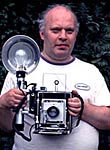|
|
 
|
|
Author
|
Topic: Annie Get Your Gun
|
|
|
|
|
Stephen Furley
Film God

Posts: 3059
From: Coulsdon, Croydon, England
Registered: May 2002
|
 posted 09-29-2004 06:36 AM
posted 09-29-2004 06:36 AM




quote: Edward Jurich
And, this print took me back for a second when I noticed the film edge was marked "KODAK NITRATE". It is of course the marking from the negative, or is it
I hadn't realised that it was old enough to have had any elements on nitrate. It's a long time since I've seen it, but it didn't look that old. It's 1950 acording to the IMDB.
I have a 1951 short which has 'NITRATE' edge printings from the negative, and I know that some of the original elements for the 1951 re-make of 'Show Boat' were on nitrate, while others were safety. This film really was something of a transition, as some of the original recordings were optical, while others were magnetic.
I can't remember the exact date now, but I know that, at least as far as Kodak products are concerned, the final nitrate base was made only a few years after the introduction of triacetate. Various other safety bases, mainly diacetate, had been available since at lease 1912, but had never been very widely used for 35mm film. Why was triacetate accepted so much more readily than the earlier safety bases had been? Was it that much better? whas the fire risk felt to be no longer acceptable?
I know that diacetate is difficult to (cement) splice, and that which I have handled tends to be brittle, but I don't know how much of that is due to age. When it was new, was triacetate that much better than diacetate that it was to become universal in just a few years, while diacetate was, for 35mm, still little used about 40 years after its introduction?
Of course, triacetate was very useful for 3-D, and was introduced just in time for the first 3-D boom.
| IP: Logged
|
|
|
|
|
|
|
|
|
|
|
|
|
|
|
|
Jeff Joseph
Expert Film Handler

Posts: 131
From: Palmdale, CA, USA
Registered: Jun 2000
|
 posted 10-01-2004 12:39 AM
posted 10-01-2004 12:39 AM





A few points:
We once had a 35mm Technicolor print of "Annie Get Your Gun"; half of it was nitrate; half was safety. It was printed right on the "cusp" of the transition to safety. The print was donated to an archive.
Warners (not MGM, Warners) did make a deal to do limited releases of the film over the last few years; they struck at least one new print. Why you'd have a print made up of several is beyond me; the new print was, well, new. And last time I checked, they did not have more than that print. What is the print number? Where did it come from?
One more note: We came across a trailer of "She Wore a Yellow Ribbon" from a mid 1950s reissue. The trailer was nitrate Technicolor, with the end cut off and a new, safety Eastman tag with a different releasing company at the end. In other words, they were sending this trailer out (this mostly nitrate trailer) into at least the mid 1950s. I suspect this is not the only time this happened.
By the way, nitrate was used later in Europe and elsewhere. There was a German 3-D short from 1952 that was release printed on nitrate stock.
Jeff
| IP: Logged
|
|
|
|
|
|
|
|
|
|
All times are Central (GMT -6:00)
|
|
Powered by Infopop Corporation
UBB.classicTM
6.3.1.2
The Film-Tech Forums are designed for various members related to the cinema industry to express their opinions, viewpoints and testimonials on various products, services and events based upon speculation, personal knowledge and factual information through use, therefore all views represented here allow no liability upon the publishers of this web site and the owners of said views assume no liability for any ill will resulting from these postings. The posts made here are for educational as well as entertainment purposes and as such anyone viewing this portion of the website must accept these views as statements of the author of that opinion
and agrees to release the authors from any and all liability.
|

 Home
Home
 Products
Products
 Store
Store
 Forum
Forum
 Warehouse
Warehouse
 Contact Us
Contact Us




 Printer-friendly view of this topic
Printer-friendly view of this topic





![[Eek!]](eek.gif)







![[Confused]](confused.gif)



![[thumbsup]](graemlins/thumbsup.gif)



